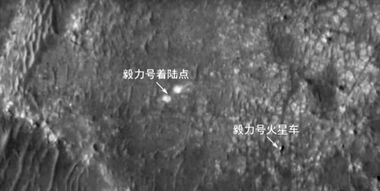Difference between revisions of "Tianwen-1"
m |
(→See also: added link) |
||
| (15 intermediate revisions by the same user not shown) | |||
| Line 1: | Line 1: | ||
| − | Tianwen-1, China’s first interplanetary mission, entered Mars orbit | + | Tianwen-1, China’s first interplanetary mission, entered Mars orbit February 10, 2021 after traveling for 202 days. It began the orbit with |
a burn about 15 minutes of its 3000N main engine at 6:52 a.m. Eastern. That was enough to permit the craft to be captured by the Red planets gravity. Tianwen-1 will gradually lower its orbit for better study of Mars. The orbiter is expected to approach as close as 265 kilometers to Mars, allowing a high-resolution camera to return images with a resolution of better than 0.50 meters per pixel. Those images will be almost as good as NASA's HiRISE images. HiRISE has a pixel size of 30-60 centimeters, or 1 to 2 feet wide.<ref> https://www.nasa.gov/mission_pages/MRO/spacecraft/sc-instru-hirise.html</ref> HiRISE can make out features that are about 3 feet (~1 meter) across (as small as a kitchen table).<ref>https://mars.nasa.gov/mro/mission/instruments/hirise/</ref> | a burn about 15 minutes of its 3000N main engine at 6:52 a.m. Eastern. That was enough to permit the craft to be captured by the Red planets gravity. Tianwen-1 will gradually lower its orbit for better study of Mars. The orbiter is expected to approach as close as 265 kilometers to Mars, allowing a high-resolution camera to return images with a resolution of better than 0.50 meters per pixel. Those images will be almost as good as NASA's HiRISE images. HiRISE has a pixel size of 30-60 centimeters, or 1 to 2 feet wide.<ref> https://www.nasa.gov/mission_pages/MRO/spacecraft/sc-instru-hirise.html</ref> HiRISE can make out features that are about 3 feet (~1 meter) across (as small as a kitchen table).<ref>https://mars.nasa.gov/mro/mission/instruments/hirise/</ref> | ||
| − | + | Tianwen-1 carries 13 science instruments. They will study Martian morphology, topography, regolith and search for water ice with radar. An examination of the Martian ionosphere, climate, and magnetic field will be performed during the planned 2 year mission. Water ice in the surface and under the surface will be mapped. | |
| + | |||
| + | On May 14,2021 the 240-kilogram solar powered rover, called [[Zhurong]], landed in Utopia Planitia.<ref> https://spacenews.com/chinas-tianwen-1-enters-orbit-around-mars/?fbclid=IwAR2znf7d1kY3_junyXkxy87H8G4dJZxhM9jDCtbIoTL2oVNPEGcbVZDu5hE</ref> <ref>https://www.space.com/china-mars-rover-landing-success-tianwen-1-zhurong</ref> | ||
| + | |||
| + | A detailed geological survey of the landing site can be found in an Icarus article published in 2021.<ref>https://www.sciencedirect.com/science/article/abs/pii/S001910352100316X</ref> <ref>Wu, X, et al. 2021. Geological characteristics of China's Tianwen-1 landing site at Utopia Planitia, Mars. Icarus. https://doi.org/10.1016/j.icarus.2021.114657</ref> | ||
| + | |||
| + | <gallery class="center" widths="380px" heights="360px"> | ||
| + | |||
| + | File:Chinaimage.jpg| China's Tianwen 1 Mars orbiter captured this photo of NASA's Perseverance rover (bottom right) on the Red Planet's surface on March 7, 2022. The other arrow, closer to the center of the frame, points out Perseverance's landing area. | ||
| + | |||
| + | File:Chinaimagerover.jpg| This undated, annotated photo from China's Tianwen 1 Mars orbiter shows the nation's Zhurong rover and some of the hardware that helped it land safely in May 2021. Image credit: CNSA via CCTV+ | ||
| + | |||
| + | </gallery> | ||
== References == | == References == | ||
{{reflist|colwidth=30em}} | {{reflist|colwidth=30em}} | ||
| + | |||
| + | =See also= | ||
| + | |||
| + | * [[Zhurong]] | ||
| + | |||
| + | * [[High Resolution Imaging Science Experiment (HiRISE)]] | ||
| + | * [[Mars Reconnaissance Orbiter]] | ||
Latest revision as of 06:50, 31 March 2022
Tianwen-1, China’s first interplanetary mission, entered Mars orbit February 10, 2021 after traveling for 202 days. It began the orbit with a burn about 15 minutes of its 3000N main engine at 6:52 a.m. Eastern. That was enough to permit the craft to be captured by the Red planets gravity. Tianwen-1 will gradually lower its orbit for better study of Mars. The orbiter is expected to approach as close as 265 kilometers to Mars, allowing a high-resolution camera to return images with a resolution of better than 0.50 meters per pixel. Those images will be almost as good as NASA's HiRISE images. HiRISE has a pixel size of 30-60 centimeters, or 1 to 2 feet wide.[1] HiRISE can make out features that are about 3 feet (~1 meter) across (as small as a kitchen table).[2]
Tianwen-1 carries 13 science instruments. They will study Martian morphology, topography, regolith and search for water ice with radar. An examination of the Martian ionosphere, climate, and magnetic field will be performed during the planned 2 year mission. Water ice in the surface and under the surface will be mapped.
On May 14,2021 the 240-kilogram solar powered rover, called Zhurong, landed in Utopia Planitia.[3] [4]
A detailed geological survey of the landing site can be found in an Icarus article published in 2021.[5] [6]
References
- ↑ https://www.nasa.gov/mission_pages/MRO/spacecraft/sc-instru-hirise.html
- ↑ https://mars.nasa.gov/mro/mission/instruments/hirise/
- ↑ https://spacenews.com/chinas-tianwen-1-enters-orbit-around-mars/?fbclid=IwAR2znf7d1kY3_junyXkxy87H8G4dJZxhM9jDCtbIoTL2oVNPEGcbVZDu5hE
- ↑ https://www.space.com/china-mars-rover-landing-success-tianwen-1-zhurong
- ↑ https://www.sciencedirect.com/science/article/abs/pii/S001910352100316X
- ↑ Wu, X, et al. 2021. Geological characteristics of China's Tianwen-1 landing site at Utopia Planitia, Mars. Icarus. https://doi.org/10.1016/j.icarus.2021.114657








